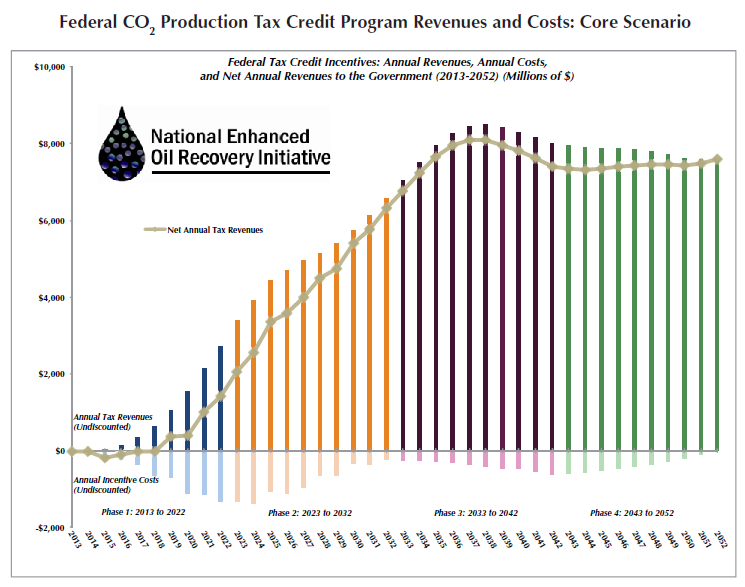Breaking Energy, July 9, 2014 (.pdf)
The Energy Collective, July 14, 2014
NEORI, the National Enhanced Oil Recovery Initiative is organized and staffed by the Center for Climate and Energy Solutions (C2ES) and the Great Plains Institute. NEORI has authored a series of innovative policy proposals to promote the use of carbon capture and sequestration, CCS, to provide much needed CO2 for the use in enhanced oil recovery, EOR. NEORI participants include a coalition of executives from the electric power, coal, ethanol, chemical, and oil and gas industries plus environmental and labor representatives, state officials, regulators, 4 U.S. Senators and a member of Congress.
The centerpiece of the NEORI proposals is a federal production tax credit for CO2 capture and transport. This revenue positive policy would provide competitively awarded tax credits to CO2 capture and pipeline projects that serve industrial facilities and power plants. Revenues will be earned back to the government by taxing the oil produced using the CO2 for EOR. Economic models indicate this program could be revenue positive within ten years.
This policy effort will enable a variety of industries including chemical plants, ethanol distilleries, oil refineries, and of course coal power plants to provide new sources of CO2 to the oil industry and help develop the technology and experience to drive innovation and lower costs for CCS broadly. These industries will benefit by lowering their carbon footprint and from developing new revenue streams marketing commodity CO2. This program will help develop the broadly applicable CO2 pipeline infrastructure needed for long term carbon sequestration in geological formations beyond oil fields.
Analysis done by NEORI indicates that the tax credit would result in the production of 9 billion barrels of American oil over the next 40 years and a commensurate reduction in the demand for oil imports from hostile foreign countries. This would amount to a quadrupling of current of CO2-EOR production and savings of roughly $610 billion on expenditures for foreign oil. The program would also lead to the permanent sequestration of approximately 4 billion tons of CO2.
The positive economic impacts include the creation of thousands of jobs all along the value chain from engineering services, skilled trade workers installing CO2 capture equipment at power plants and industrial facilities, construction on thousands of miles of new CO2 pipelines, new work revitalizing old oil fields and materials suppliers. Local and state governments benefit from taxes earned all along the value chain and increased employment for their citizens.
The U.S. CO2-EOR industry has been profitable for decades and is not actively lobbying for financial incentives to expand their operations beyond current levels. The industry is constrained though by a lack of new sources of CO2. The industry historically has used a combination of natural deposits underground and inexpensive anthropogenic CO2 from natural gas cleanup operations. Natural CO2 domes have mostly been tapped and offer limited expansion while inexpensive industrial sources of CO2 are also limited. Incentives are required to expand the potential of CO2-EOR for the benefit of both large scale carbon sequestration and increased domestic oil production.
The resource potential for CO2-EOR is very large. NEORI references Advanced Resources International (ARI) who have been researching the industry for decades and have done much of the primary research for the Department of Energy. ARI estimates that “next-generation” EOR could sequester from 20-45 billion metric tons of CO2, this quantity of CO2 is equal to total U.S. CO2 production from fossil fuel electricity for 10-20 years. The amount of oil produced from these operations range from 67-137 billion barrels of oil. These numbers are based only on continental US production and do not include Alaska, Gulf of Mexico, or shale such as the Bakken in North Dakota all of which offer CO2-EOR opportunities.
U.S. federal policy has long promoted carbon capture and sequestration of CO2 from power plants and other industrial facilities. CCS has only seen limited growth though due to high costs and a lack of regulations limiting CO2 emissions. Now the EPA is proposing new rules under the Clean Air Act including the New Source Performance Standards for new coal power plants which mandate partial CCS. But there is no financing mechanism to help make new coal plants competitive with natural gas power plants, contributing to the impression that the EPA rules amount to a war on coal. In the rules the EPA states that CO2 sales for EOR should help offset the costs for plant operators but the commercial reality today is that there is a price gap between the cost of CO2 capture and the price the EOR industry can pay which is a function of the price of oil. The NEORI proposal attempts to address that price gap.
The NEORI proposal was first published in 2012 and predates the EPA’s new carbon rules, but it offers the framework for a political bargain that offers benefits for the environment, job creation and domestic energy security.
For more information and expanded detail see NEORI’s website and published papers.
